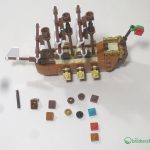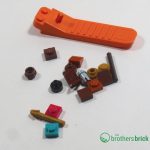A few weeks ago, LEGO announced the release of the first LEGO Ideas set in 2018, 21313 Ship in a Bottle, available at the LEGO Shop online. The successful LEGO Ideas project was originally submitted by Jake Sadovich and is a LEGO version of the classic concept of a ship in a bottle — a perfect mix of art and craftsmanship.
The set contains 962 pieces and retails for $69 (obviously with variations in other countries), which falls deep within the magic 10 cents per piece zone. However, you will need to judge the real value for yourself, as several hundred of the elements that make up the part count are sized 1×1 or 1×2, most notably the 284 1×1 round plates in translucent light blue.
The box and instructions
The Ship in a Bottle box art is quite good, with antique nautical imagery like portholes and drawings on aged paper depicting the ship, compasses, maps, and a sea monster here and there.
The back of the box shows the ship out of the bottle, seen through an open porthole.
As is the tradition with Ideas sets, the instructions booklet contains information on the set, and as this set is not licensed the accompanying text speaks about the designers and the process.
The build
The set contains four groups of bags and four loose pieces — the Panel 6 x 6 x 9 Corner Convex with Curved Top (which had been out of production for some time). The first bag contains the pieces to build the ship, the Leviathan. The second bag contains almost exclusively translucent pieces for building most of the bottle. There are three bags numbered with a 3 and they contain only translucent light blue 1×1 round plates. The last bag, numbered 4, has the bricks needed to complete the bottle (the instructions include the large panel pieces in the fourth segment of construction) and to build the stand.
While building, I have used rubber gloves to keep the translucent parts clean of fingerprints, which is important for a model like this, as it focuses on display value and the bottle needs to stay clean for the ship to be as visible as possible. There were a few awkward moments in the construction, as the bottle does not have any stable base to support it, so sometimes the force of connecting new elements somewhat twists the numerous 1×2 plates around a bit. I’d recommend building the set on a sturdy table.
As stated previously, the first bag contains pieces to build the ship. Notable pieces include many somewhat new 1×1 pieces in new colours, like the 1×1 “nipple” piece and a brown fez.
There are many Plate, Modified 1 x 1 Rounded with Handle in this part of the build, and for less experienced builders, setting them straight might prove to be somewhat frustrating. While I appreciate the “nipple” pieces in black, the cannons look somewhat off with the wide black circle around the gun and there are probably ways to make them work better. The flag in the back could use a printed tile instead of a red 1×1 plate. Aside from these criticisms, the ship is actually really well-done, with beautiful colour blocking on the back and a masterful studs-out construction, where everything seems to just magically fall into place without a seam.
The second bag contains a large amount of translucent clear parts, mostly 1×2 plates and quite a few headlight bricks too, which was a surprise to be sure, but a welcome one. The base of the bottle is very textured, but that is actually fine because real bottles are indeed less clear on the bottom. The bag system here deserves a mention; if you do not mix the parts from different bags, it is astonishingly easy to find precisely the parts you need in the mess of tiny translucent bricks. This bag was also the time I needed to put on my gloves. Looking at the completed set, I think doing so was very much worth it.
The ship fits very tightly in the bottle, which seems designed to keep the ship in place. Notably there are no spare parts in this bag, although it contains 1×1 plates and cheese slopes in translucent clear – a colour even easier to misplace than say, dark turquoise (although less exciting to get a spare of!).
The third set of bags is just the “water”, 284 translucent light blue 1×1 round plates (plus spare parts?), which are separated into three bags for some reason. The biggest question though, is why 284 and not some other number. The loose parts seem to be an interesting new paradigm for LEGO, but I will discuss it further in the conclusion of the review.
The last bag contains some parts to finish off the bottle, like the neck and cork, as well as the stand with the awesome little nameplate. The base includes some progressive techiques even a seasoned builder would learn a thing or two from, as well as very well hidden dark turquoise parts.
There are some awesome parts in brown, like hinge elements, wedge plates and many brackets.
The base is neat, but not overly detailed, which actually helps it in my opinion. Too many details would detract from the focal point of the set, and it would not look like the real deal either.
Conclusions & recommendation
I have a great appreciation for LEGO Ideas sets that are not based on pre-existing themes and intellectual property, as I see it as much greater of an achievement to rally support for a truly unique idea (in this case amazingly in only 48 days!), and I also think it is more in the “spirit of LEGO” as a creative toy. Ironically, the only other Ideas set in my personal possession is the Adventure Time set, but I was personally inspired to build my own creations resembling Peter Reid’s Exo-Suit. This sentiment has made me very excited to review the Ship in a Bottle and upon seeing the pieces included, I got even more excited. For my personal budget the $70 price tag was somewhat offputting, even with the low price per piece and number of widely useful pieces in mind.
There are many advanced techniques used, and even though sets have been getting more complex overall, this particular set was something else entirely. Adding to that the “loose studs for water” technique, which is widespread amongst LEGO fans of all ages and experience levels, it makes me question how far LEGO will go in making sets less and less compatible with the most hardcore views on purist techniques. On the other hand, loose pieces were always present in sets, just in more conservative amounts – an odd animal here and there, an unconnected bush or some gold bars and jewels in crates or chests – and how is this much different?
Another observation is that the larger translucent pieces seem to have an oddly soft sound to them and a more purplish hue when viewed from the side, as opposed to the normal yellowish colour. While I like purple, I ask myself whether bringing back a 20-year-old element for a single set has resulted in a quality difference. Lower quality or not, I suggest that if you disassemble this set, try to keep the large translucent panels separate from other parts, so they do not get dirty and scratched up as many of my other panels did, reducing their aesthetic appeal greatly.
I have some criticisms of this set, most notably how tightly the ship fits in the bottle, the bottle’s gaps, and questions about plastic quality. But even considering all this, the set is still my favourite of recent years in terms of design, as well as building experience. Besides, the biggest problem I have with it — the seams between the bottle’s panels — are not especially bothersome in person.
As far as playability goes, the set has as much as a conventional ship in a bottle, which is nearly zero, but it has exactly as much and possibly more display value. I can imagine almost anyone having this build on their shelf to show off to their friends and to spark a conversation, even if they are not a LEGO fan in general (in which case, though, I am concerned that the building process might be challenging to inexperienced builders). Catering to a wide audience was one of the goals of the design team at LEGO, and it was most definetely achieved. The true potential of this set however, comes in its ability to easily be modified – to house a new ship or maybe just to be a bottle filled with whatever colour of LEGO you want!
There are many elements in the set that are rare in certain colours or completely new to them, like a brown fez, 1×1 plates with handle and obviously the domed clear panels. The price per piece is good, but with the “water” out of the equation (which many builders have a lot of already or can get significantly cheaper on Bricklink or on Pick-a-Brick walls), the numbers become more average. In the end, I believe the set is very much worth buying for display and for the rare and new parts, which will surely come in handy at least for custom LEGO creations.
LEGO Ideas 21313 Ship in a Bottle includes 962 pieces and will be available beginning February 1. You can purchase it from the LEGO Shop ($69.99 in the US | $89.99 in Canada | £69.99 in the UK), Amazon, BrickLink, and eBay.
The LEGO Group sent The Brothers Brick a copy of this set for review. Providing TBB with products for review guarantees neither coverage nor positive reviews.



































This is the first Ideas set that I feel really took a step back in quality/interest after the LEGO designers added their input. The ship looks more like a barge than in the original Ideas submission and the bottle is less interesting. I’m on the fence on picking it up now whereas the original submission could have been one of my all-time favorites.
This set did not do justice to the original Ideas submission.
While the stand looks great, the ship and the bottle is a major let-down. Taking the ‘water’ off the piece-count and the ppc is pushed above 10c/piece. (Let’s not talk about the £=$=€ price either.)
good review–i loved the initial pitch, was dissatisfied with the final product, but now might end up buying this anyway.
Your mention of the many loose pieces got me thinking of the 1981 public works set i had growing up, and its many loose 1×1 bricks.
https://www.bricklink.com/catalogItemInv.asp?S=6383-1
Though now suddenly 20 loose bricks doesn’t seem like all that many.
Have to agree with Jason. This was one I was really excited to buy, but now I’m on the fence. While I think they did improve some aspects of the set, it definitely feels inferior overall. I was hoping LEGO designers would streamline the bottle, which they did, but at the expense of its overall size. The chunky, squatty boat is the worst part – his was elegant and and grand.